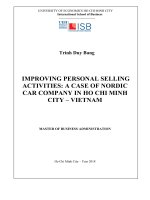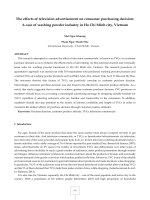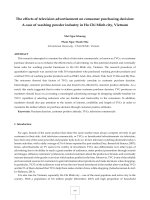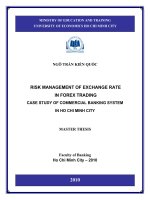A case study of word stress production in speaking performance by efl learners at a language center in ho chi minh city
Bạn đang xem bản rút gọn của tài liệu. Xem và tải ngay bản đầy đủ của tài liệu tại đây (1.38 MB, 77 trang )
VIETNAM NATIONAL UNIVERSITY – HO CHI MINH CITY
UNIVERSITY OF SOCIAL SCIENCES AND HUMANITIES
FACULTY OF ENGLISH LINGUISTICS AND LITERATURE
A CASE STUDY OF WORD STRESS PRODUCTION IN
SPEAKING PERFORMANCE BY EFL LEARNERS
AT A LANGUAGE CENTER IN HO CHI MINH CITY
A thesis submitted to the
Faculty of English Linguistics & Literature
in partial fulfillment of the Master’s degree in TESOL
By
HOANG THI DOAN
Supervised by
NGUYEN THI NHU NGOC, Ph.D.
HO CHI MINH CITY, DECEMBER 2022
VIETNAM NATIONAL UNIVERSITY – HO CHI MINH CITY
UNIVERSITY OF SOCIAL SCIENCES AND HUMANITIES
FACULTY OF ENGLISH LINGUISTICS AND LITERATURE
A CASE STUDY OF WORD STRESS PRODUCTION IN
SPEAKING PERFORMANCE BY EFL LEARNERS
AT A LANGUAGE CENTER IN HO CHI MINH CITY
A thesis submitted to the
Faculty of English Linguistics & Literature
in partial fulfillment of the Master’s degree in TESOL
By
HOANG THI DOAN
Supervised by
NGUYEN THI NHU NGOC, Ph.D.
HO CHI MINH CITY, DECEMBER 2022
STATEMENT OF ORIGINALITY
I hereby certify my authorship of the thesis submitted today entitled:
A CASE STUDY OF WORD STRESS PRODUCTION IN SPEAKING
PERFORMANCE BY EFL LEARNERS AT A LANGUAGE CENTER
IN HO CHI MINH CITY
In terms of the statement of Requirements for the Thesis in Master’s Program issued by
the Higher Degree Committee. The thesis has not been submitted for the award of any
degree or diploma in any other situations.
Ho Chi Minh City, December 2022
HOANG THI DOAN
i
RETENTION AND USE OF THE THESIS
I hereby state that I, Hoang Thi Doan, being the candidate for the degree of Master in
TESOL, accept the requirements of the University of Social Sciences and Humanities
relating to the retention and use of Master’s Theses deposited in the library.
In terms of these conditions, I agree that the original version of my thesis deposited in
the library should be accessible for the purpose of study and research, in accordance
with the normal conditions established by the library for the care, loan or reproduction
of the thesis.
Ho Chi Minh City, December 2022
ii
ACKNOWLEDGEMENTS
I would like to express my gratitude to those who have helped and supported me during
the hard time doing my research and completing this thesis. First, my deepest
gratefulness goes to my respectful supervisor, Dr. Nguyen Thi Nhu Ngoc, for
encouraging me to continuously review literature, write up and revise my thesis and
providing me with valuable feedback and precious guidance throughout the tiring stages
of doing research and thesis writing. I am also grateful to Dr. Tran Thi Thanh Dieu for
her help during my first step to come up with the research.
I am thankful for the continuous support that the management of the Faculty of English
Linguistics and Literature provided when I was working on my thesis. My genuine
appreciation also goes to my colleagues, for all the generous and enthusiastic support
and the invaluable and professional advice they have given to help me better understand
the issue under investigation.
Last but not least, I am very grateful to my incomparably caring and loving family for
always being by my side to cheer me up when I suffered stress from my work and study.
Without the encouragement, support and guidance provided by those named or unlisted,
I would not have completed this Master’s Thesis.
I appreciate all
iii
TABLE OF CONTENTS
STATEMENT OF ORIGINALITY ..................................................................................................... i
RETENTION AND USE OF THE THESIS ...................................................................................... ii
ACKNOWLEDGEMENTS ................................................................................................................ iii
LIST OF ABBREVIATIONS ............................................................................................................. vi
LIST OF TABLES.............................................................................................................................. vii
LIST OF FIGURES........................................................................................................................... viii
ABSTRACT ......................................................................................................................................... ix
CHAPTER 1
INTRODUCTION..................................................................................................... 1
1.1 BACKGROUND TO THE STUDY .......................................................................................... 1
1.2 AIMS OF THE STUDY ............................................................................................................. 3
1.3 RESEARCH QUESTIONS........................................................................................................ 3
1.4 SCOPE OF THE STUDY .......................................................................................................... 4
1.5 SIGNIFICANCE OF THE STUDY .......................................................................................... 4
1.6 ORGANIZATION OF THE THESIS ...................................................................................... 4
CHAPTER 2 LITERATURE REVIEW ......................................................................................... 6
2.1 WORD STRESS ......................................................................................................................... 6
2.1.1 Definition .............................................................................................................................. 6
2.1.2 Features of word stress ....................................................................................................... 7
2.1.3 Analysing word stress using the PRAAT application .................................................... 11
2.2 SPEAKING PERFORMANCE ............................................................................................... 12
2.2.1 Definition ............................................................................................................................ 12
2.2.2 Oral presentation ............................................................................................................... 13
2.2.3 Storytelling ......................................................................................................................... 14
2.2.4 Factors affecting word stress production in speaking performance ............................. 14
2.3. PREVIOUS STUDIES ............................................................................................................ 16
2.4. CONCEPTUAL FRAMEWORK .......................................................................................... 19
CHAPTER 3 METHODOLOGY .................................................................................................. 21
3.1 RESEARCH DESIGN.............................................................................................................. 21
3.2 RESEARCH SITE .................................................................................................................... 22
3.3 PARTICIPANTS ...................................................................................................................... 23
3.4 ENGLISH COURSES AND MATERIALS ........................................................................... 24
3.5 RESEARCH INSTRUMENTS................................................................................................ 25
3.6 PROCEDURE OF DATA COLLECTION ............................................................................ 27
3.7 DATA ANALYSIS PROCEDURE ......................................................................................... 31
iv
CHAPTER 4 RESULTS AND DISCUSSIONS ............................................................................ 32
4.1 RESEARCH QUESTION 1 ..................................................................................................... 32
4.1.1 RESEARCH QUESTION 1A ........................................................................................... 32
4.1.2 RESEARCH QUESTION 1B ........................................................................................... 37
4.2 RESEARCH QUESTION 2 ..................................................................................................... 40
4.2.1 Topical knowledge ............................................................................................................. 40
4.2.2 Native language/Mother tongue influence ....................................................................... 41
4.2.3 Exposure ............................................................................................................................. 41
4.2.4 Planning .............................................................................................................................. 42
4.2.5 Time pressure..................................................................................................................... 43
4.2.6 Amount of support ............................................................................................................ 43
4.2.7 Motivation and concern for good pronunciation ............................................................ 43
4.2.8 Standard of performance/ Pressure to perform well...................................................... 44
4.3 DISCUSSION............................................................................................................................ 45
4.3.1 Students’ word stress production in speaking performance ......................................... 45
4.3.2 Factors affecting students’ word stress production in speaking performance ............ 46
CHAPTER 5 CONCLUSION ......................................................................................................... 48
5.1 SUMMARY OF THE MAJOR FINDINGS........................................................................... 48
5.2 IMPLICATIONS ...................................................................................................................... 49
5.3 LIMITATIONS OF THE STUDY .......................................................................................... 50
5.4 RECOMMENDATIONS ......................................................................................................... 50
REFERENCES ................................................................................................................................... 52
APPENDIX A ..................................................................................................................................... 56
APPENDIX B ...................................................................................................................................... 57
APPENDIX C ..................................................................................................................................... 58
APPENDIX D ..................................................................................................................................... 59
APPENDIX E ...................................................................................................................................... 62
APPENDIX F ...................................................................................................................................... 65
v
LIST OF ABBREVIATIONS
A2 level
Elementary level
EFL
English as a Foreign Language
ELT
English language teaching
CEFR
Common European framework of reference for languages
HCMC
Ho Chi Minh City
RP
Standard pronunciation or Received Pronunciation
vi
LIST OF TABLES
Table 2.1 Summary of features of word stress by scholars ........................................ 10
Table 2.2 Extensive speaking performance tasks ....................................................... 13
Table 2.3 Factors affecting word stress production in speaking performance ......... 16
Table 3.1 Students’ information ................................................................................. 23
Table 3.2 The summary of the research procedures .................................................. 30
Table 4.1 Loudness comparison of the word “admire” between RP and students’
samples ........................................................................................................................ 33
Table 4.2 Pitch comparison of the word “admire” between RP and students’ samples
..................................................................................................................................... 35
Table 4.3 Duration comparison of the word “admire” between RP and students’
samples ....................................................................................................................... 36
Table 4.4 Loudness comparison of the word “inside” between RP and students’
samples ........................................................................................................................ 38
Table 4.5 Summary of the factors affecting word stress production in speaking
performance ............................................................................................................... 45
vii
LIST OF FIGURES
Figure 2.1 Illustration of the frequency of the sound .................................................. 8
Figure 2.2 Illustration of pitch (blue line) and loudness (yellow line) of the sound .... 9
Figure 2.3 Illustration of duration of the sound ......................................................... 10
Figure 2.4 Platform of the PRAAT application .......................................................... 11
Figure 2.5 The conceptual framework of the study ................................................... 20
Figure 4.1 Spectrogram of pitch (blue line) and loudness (yellow line) comparison of
the word “admire” between RP (left) and student’s samples (right) ........................ 32
Figure 4.2 Spectrogram of pitch (blue line) and loudness (yellow line) comparison of
the word “person” between RP (left) and student’s samples (right) ........................ 34
Figure 4.3 Spectrogram of pitch (blue line) and loudness (yellow line) comparison of
the word “owner” between RP (left) and student’s samples (right) ......................... 39
viii
ABSTRACT
Word stress has much been concerned in learning English as a foreign language (EFL).
As it is one of the essential factors in pronunciation, focusing on word stress helps EFL
learners with intelligibility in communication. This study was conducted to discover
the word stress production in speaking performance of 23 EFL students at level A2
(based on the Common European Framework of Reference for Languages) through oral
presentation and storytelling - at a language center in Vietnam as well as some factors
affecting their word stress production in speaking performance. Using the PRAAT
software, the researcher compared the student pronunciation with RP, paying particular
attention to disyllabic words created by students. The findings showed that, regardless
of other aspects of pronunciation, students at the language center under investigation
lacked sufficient knowledge and proficiency in word stress, which led to certain word
stress errors in their speaking performance. Using the students’ semi-structured
interviews, the researcher found out a number of factors including topical knowledge,
planning, motivation, and concern for proper pronunciation, pressure when presenting,
students' lack of exposure, as well as mother tongue influence, were found to have an
impact on students' word stress production. The results contribute to understanding of
how the EFL learners produced word stress in speaking performance in forms of oral
presentation and storytelling and some possible factors affecting their word stress
production in speaking performance. Thus, the findings help suggest some important
implications for learning and teaching with respect to word stress, as well as relevant
research.
Keywords: word stress production, speaking performance, oral presentation,
storytelling, factors affecting word stress production
ix
CHAPTER 1
INTRODUCTION
1.1 BACKGROUND TO THE STUDY
Being used for a variety of purposes in different fields, English is the most common
language that students of all ages around the world are studying. English has been
learned for immigration to an English-speaking country, for travelling purposes or
entertainment, and has been used widely as a mediating language of international
business (Harmer, 2007). Obviously, the ultimate goal of learning English is for
students to be able to communicate with English speakers, both native and non-native
ones.
Among three language areas, pronunciation is definitely an important factor in speaking
as it interferes with communication. Pronunciation is associated with understandability
or intelligibility, as "pronunciation is a central factor in students' success in making
themselves understood" (Avery and Ehrlich, 1992). Pronunciation is put into two
categories: the segmental features (consonant and vowel sounds) and the
suprasegmental ones (stress, rhythm, and intonation) (Celce-Murcia et al., 2014), so it
is important to know about and practice both segmental and suprasegmental features.
Both of the features work together to make pronunciation understandable to listeners
(Yoshida, 2013).
Word stress is one of the suprasegmental features of pronunciation, and also a must for
learners to acquire to be successful in speaking. Benrabah (1997, as cited in Levis,
2018) concludes that native as listeners tend to impose their interpretation based on
their “aural expectancies” relying heavily on the stress pattern produced and totally
disregarding segmental information. Kenworthy (1988) states experiments have
demonstrated that often when a native speaker mishears a word, it is because the
foreigner has put the stress in the wrong place, not because he or she mispronounced
the sounds of the word. Furthermore, O’Brien (2019) mentions that a number of
1
previous studies have demonstrated the importance of accurate lexical stress
assignment in being understood (e.g., Caspers, 2010; Trofimovich and Isaacs, 2012).
The experimental study by Hahn (2004) shows the importance of primary stress and its
effect, not only on intelligibility, but also sociolinguistically, in terms of role
relationships in discourse (as cited in Hodgetts, 2020). Sharing the same viewpoint,
Yoshida (2013) said “It’s very important for learners to put the stress in the right place.
If the wrong syllable is stressed, listeners may not be able to understand what word is
being said.”
However, it can often be a difficult area for learners of English to master successfully
and one which is problematic for teachers of pronunciation to embrace in their teaching
(Field, 2005, as cited in Checklin, 2012). An investigation in Vietnam by Nguyen
(2007) revealed numerous difficulties of students in English pronunciation study,
including not placing stress or misplacing stress on a word syllable declared by 91% of
the students. It is also among the aspects of pronunciation which needs to be considered
while “lacking knowledge of pronunciation is one of the factors inhibiting students’
speaking performance” (Doan, 2012). As it is crucial for both the listeners and speakers
of English to comprehend, students should pay attention to their word stress in speaking
to ensure intelligibility in communication.
In the language center where the study was conducted, speaking skills are among the
four skills that students need to achieve at the end of the course, so different types of
speaking tasks were employed to help students practice their skills. When speaking
English, many EFL learners encounter certain pronunciation issues, one of which is the
incorrect production of lexical stress, particularly their inability to produce stress
contrasts of multisyllabic words. Concerningly, the researcher discovered through
informal conversations with these learners that they did not appear to be aware of the
importance of lexical stress in English pronunciation.
2
Although numerous studies have been conducted in Vietnam to investigate learners'
English pronunciation ability, there has been a limited amount of research focusing on
suprasegmental aspects, particularly word stress patterns (An, 2010, as cited in Tuan,
2018).
Regarding speaking performance, Brown and Abeywickrama (2019) categorize
speaking performance into five types, including imitative, intensive, responsive,
interactive, and extensive. Such types of activities have been utilised in classroom
context where students could practice using English in order to boost their
communicative competence.
It is the rationale for the researcher to decide to conduct the study entitled “A case study
of word stress production in speaking performance by EFL learners at a language
center in Ho Chi Minh City”.
1.2 AIMS OF THE STUDY
This study aims to explore students’ word stress production in extensive speaking
performance in forms of oral presentation and storytelling by EFL learners at a language
center in Ho Chi Minh City (HCMC) as well as to examine factors affecting their word
stress production in speaking performance.
1.3 RESEARCH QUESTIONS
In order to achieve the research aims, three research questions are formulated:
1. How do EFL learners produce word stress in their speaking performance?
Sub-questions: 1a. How do EFL learners produce word stress in oral presentation?
1b. How do EFL learners produce word stress in story-telling?
2. How do students perceive factors affecting their word stress production in speaking
performance?
3
1.4 SCOPE OF THE STUDY
The research focuses on discovering the production of word stress of the EFL teenage
students at level A2 (elementary in the Common European Framework of Reference
for Languages (CEFR) in speaking performance at a suburban English language center
in HCMC. Therefore, the study is restricted to a certain case of a number of young
students at the language center under investigation. Specifically, the data to be collected
would be narrowed down to 23 students of two A2 classes at the center, not all of them
to be mentioned. Importantly, it was noticed by the researcher that the A2 level students
at the language center under investigation made quite a lot of mistakes in word stress
during their speaking performance. Hence, stress production in speaking performance
was taken into consideration in this study. Besides, the researcher put the focus on
speaking performance in forms of oral presentation and storytelling, the two speaking
forms employed in the two classes during the research time.
1.5 SIGNIFICANCE OF THE STUDY
This study is worth conducting because of the two reasons. First, this study would
contribute to the research on word stress production in speaking performance. Though
there has been quite a vast amount of research on word stress as well as speaking
performance, there is limited research on word stress production of students regarding
speaking performance. Second, it would hope to bring some practices and experiences
of word stress production to students at the language center under investigation. The
outcome could be utilized to show learners whether their word stress is correct or
incorrect, as well as help them be aware of word stress production not only in isolation
but also in utterance. In addition, the researcher and her colleagues would deeply look
into the situation and help students with their learning better.
1.6 ORGANIZATION OF THE THESIS
This thesis consists of six chapters as follows.
4
Chapter 1 gives introduction to the thesis.
Chapter 2 reviews relevant literature on word stress and speaking performance to
supply a clearer context for addressing the research questions.
Chapter 3 explains the methods that have been used for collecting and analysing data
in this study. It provides details of the research site and participants, as well as the
procedures used for data collection and analysis.
Chapter 4 presents the results of analysis aimed at answering the three research
questions. These results are then discussed in relation to earlier studies on word stress
and factors affecting their word stress production in speaking performance.
Chapter 5 summarizes major research findings as well as the limitations, based on
which it points out implications for teaching practice and further research on the topic
of word stress and speaking performance.
5
CHAPTER 2
LITERATURE REVIEW
The first chapter draws attention to the motivations for investigating students’ word
stress production in speaking performance. This chapter searches for an analytical
model to address these concepts. First, it starts with a discussion on word stress, its
features, and a computer-based application to analyse the word stress production.
Second, relevant factors affecting students’ speaking performance are discussed in
detail. Finally, the chapter concludes by adapting a model of identifying word stress
production and affecting factors in speaking performance in forms of oral presentation
and storytelling.
2.1 WORD STRESS
2.1.1 Definition
In English, the word stress has been a subject of extensive research in recent years and
the phenomenon of stress has received considerable attention from linguists. Some
scholars have provided definitions of the term word stress.
Some linguists relate word stress to the prominence of sound characteristics, including
length, loudness, pitch and vowel quality. Celce-Murcia et al. (2002) state that
“Stressed syllables are most often defined as those syllables within an utterance that are
longer, louder and higher in pitch”. Rogers (2000) also shares the same idea that “Stress
in English is manifested by a combination of three phonemic elements: greater
loudness, higher pitch, and longer duration”.
In sum, these definitions show the factors that characterize a word stress and make the
stressed syllable more prominent than other syllables of a word.
6
2.1.2 Features of word stress
Some features of word stress have been listed as the measurement criteria in many
studies. According to Fear et. al. (1995), stressed syllables contain vowels that are
pronounced with higher pitch and intensity and are longer than vowels in unstressed
syllables. Typically, unstressed syllables contain the vowel schwa or a short form of a
vowel (Cutler and Norris, 1988). In contrast, stressed syllables contain only full vowels,
making stressed syllables longer than unstressed ones (Van Donselaar et. al., 2005).
Fry (1955) identifies word stress by duration and intensity of the vowel. He claims that
when the vowel is long and of high intensity, listeners agree that the vowel is strongly
stressed, when it is short and of low intensity, it is judged as weakly stressed. The results
of his experiments also shows that duration and intensity ratios are both cues for
judgments of stress and that, in the material studied, duration ratio is a more effective
cue than intensity ratio. In the same vein, Dieu (2015) demonstrates the errors in
English word stress made by Vietnamese learners using intensity and pitch as her
criteria.
Roach (2009, p.74) claims that all stressed syllables have one common characteristic,
that is prominence, with four important factors: loudness, movement of pitch, length
and quality. He also points out that pitch and length are the strongest and most powerful
factors while loudness and quality have much less effect. Similarly, Hector (1999, p.8)
describes four elements which produce prominence at syllable level: pitch contrast,
loudness, length and quality. He explains that all the four elements can play a part in
making a syllable stand out over the rest, and that they do not play an equally important
part. In his viewpoint, the most important element is pitch contrast, as he asserts the
really prominent syllables are identified when they display the most decisive of the
elements producing the prominence – pitch contrast.
Many other linguists share the same view on the characteristics of word stress prominence, including three phonetic elements: greater loudness, higher pitch, and
7
longer duration (Deterding and Poedjosoedarmo, 1998; Rogers, 2000; Celce-Murcia et.
al., 2002; Clark et. al., 2007). Likewise, Hulst (2014) indicates that stress is cued by a
combination of increased duration and intensity and higher fundamental frequency
(pitch).
All in all, the most common features of word stress shared by many researchers are
loudness (i.e. intensity), pitch and duration (i.e. length). In this study, these three
elements of stressed syllables were examined as the judgment of word stress among the
tokens.
(1) Loudness
First, the loudness or intensity of sounds is correlated to amplitude. Benus (2021, p.53)
mentions that amplitude corresponds to the force of the excitation for the air particles:
greater force corresponds to greater displacement of the particles and thus greater
fluctuation of air pressure. Hence, amplitude corresponds roughly to the loudness of
sounds. As could be seen from the below figure, two waves have the same frequency
(440 Hz) but different amplitude: the left one has greater amplitude, and the resulting
sound is thus louder than the right one.
Figure 2.1 Illustration of the frequency of the sound
(extracted from Benus, 2021)
(2) Pitch
8
Second, pitch is the auditory impression created by variations in the rate of vibration of
the vocal folds (Carr, 2013). In other words, articulatorily pitch depends mainly on the
tension and consequent rate of vibration of the vocal folds. Auditorily, it is that property
of a sound in terms of which it can be placed on a scale running from high to low
(Hector, 1999). The following illustration is the waveform (top) and spectrogram
(bottom) of the recording “admire” by a native speaker. The pitch of a sound is indicated
by a blue line near the baseline on the spectrogram, and the yellow line corresponds to
the loudness.
Figure 2.2 Illustration of pitch (blue line) and loudness (yellow line) of the sound
(extracted from PRAAT)
(3) Duration
Hulst (2014), sharing the same respect with Fry (1995), claims duration to be the most
reliable cue to stress followed by intensity and then fundamental frequency. According
to Hector (1999), duration or length, auditorily, is the property that enables us, using
only our ears, to place it on a scale that goes from long to short. In the following
waveform and spectrogram, the horizontal axis represents time with the total duration
at the bottom of the chart, together with the duration of each syllable under the
spectrogram.
9
Figure 2.3 Illustration of duration of the sound
(extracted from PRAAT)
In sum, the current study takes into consideration these following features of word
stress as the criteria of word stress production. In addition, word stress of disyllabic
words was taken into account as it was easier for students at elementary level to
recognize the difference between the two syllables, which including merely stressed
and unstressed syllables.
Table 2.1 Summary of features of word stress by scholars
Celce-Murcia et. al.(2002), Roach (2009),
Deterding and
Fry (1955)
Hector (1999)
Poedjosoedarmo (1998),
Rogers (2000), Clark et. al.
(2007), Hulst (2014)
Loudness
Loudness
Intensity
Pitch
Movement of pitch
Duration
Duration
Length
Quality
It can be seen that various scholars have used different terms to describe the features of
word stress in English but they share similar descriptions. And the current study
10
supports the view of most of them. Thus, the three features namely loudness, pitch, and
duration are used to measure the student participants’ word stress production in this
thesis.
2.1.3 Analysing word stress using the PRAAT application
Being the subject for several research, word stress has been examined by different ways
and computer-based applications. The aforementioned elements are taken into
consideration for the analysis of the word stress production by the EFL learners at the
language centre under scrutiny.
Among a variety of computer-based applications, PRAAT appears to be the most
suitable one which can manipulate different aspects of speech sounds, therefore, it is
most often used by many linguists (phoneticians, phonologists, syntacticians). PRAAT
is a computer program for analysing, synthesizing, and manipulating speech. It has been
developed since 1992 by Paul and Weenink at the Institute of Phonetic Sciences of the
University of Amsterdam. Interestingly, not only is it used in linguistic explorations but
it can also be used by musicians and bio-acousticians for the analysis of sounds
produced by flutes, drums, crickets, or whales.
Figure 2.4 Platform of the PRAAT application
11
Georgaki and Psaroudakes (2014) used Praat as their platform to manipulate the data in
their study because it provides an existing suite of high-quality speech analysis routines,
such as pitch tracking, duration, energy (i.e. intensity).
Also, Zuraiq and Sereno (2021) investigated English lexical stress cues in second
language learners. The recordings are digitized and analyzed using PRAAT in terms of
duration, fundamental frequency, amplitude, and second formant frequency.
Boersma and Heuven (2014) list numerous advantages of PRAAT as it has been used
for most of the phonetic research not only because it is the most complete program
available and distributed for free, but also because it comes with the finest algorithms.
Furthermore, for convenience, PRAAT has been designed to interface reasonably well
with Matlab, SPSS, Excel, and the Klatt synthesizer.
Based on the descriptions above, PRAAT is the most appropriate application to be
chosen for measuring speech sounds in the current study.
2.2 SPEAKING PERFORMANCE
2.2.1 Definition
According to Brown (2014, p.34), performance is actual production or the
comprehension of linguistic events. He also clarifies that performance is the actual
doing of something: walking, singing, dancing, speaking. In this study, speaking
performance of students is taken into consideration, and it is understood that students
do their oral and verbal communication.
As mentioned earlier in the Introduction, extensive speaking is among the types of
speaking performance tasks that could be utilised to enhance students’ speaking
competence. Some scholars have defined extensive speaking as a monologue – a speech
by one person (Burns and Goh, 2012, Brown and Abeywickrama, 2019). According to
Brown and Abeywickrama (2019), in this task type, students are required to give
12
extended monologues in the form of oral reports, summaries, or perhaps short speech.
Some linguists categorise extensive speaking tasks into different types as listed in Table
2.2.
Table 2.2 Extensive speaking performance tasks by scholars
Burns and Goh (2012)
Brown and Lee (2015)
Oral presentations
Telling a story
Picture-cued storytelling
Responding and sharing
Retelling a story or news event
Sharing personal anecdotes
Translation of an extended text
Giving a talk.
In this study, word stress production in speaking performance was investigated via oral
presentation/giving a talk and storytelling. In the research context, they were the two
speaking activities frequently designed and applied for A2 level students in many
language centers in Vietnam. Thus, in the next sections, the activities of oral
presentation and storytelling in EFL students’ speaking performance is reviewed in
detail.
2.2.2 Oral presentation
In the current study, oral presentation, talk, and speech are used as mutual substitution.
As Mandel (2000) asserts, the terms "speech" and "presentation" are often used
interchangeably. Kazemi and Zarei (2014) define oral presentation as a short talk on a
particular topic given to a seminar or a tutorial group where one (or more) students give
a talk and express their views on a topic in accordance with their readings or research.
To suit the case of the study, the task for young learners should be limited to genres that
they are familiar with, such as narratives and information reports (Burns and Goh,
2012). Accordingly, in this study, students delivered a short talk - oral presentation, one
13
of the extensive speaking tasks as listed by Brown and Abeywickrama (2019), on a
familiar topic in order to examine their production of word stress in monologue. This
type of task is adequate for EFL teenage learners at A2 level at the center under
investigation.
2.2.3 Storytelling
According to Hwang et. al. (2016), storytelling is designed to increase involvement in
learning. Guha et. al. (2007) refer storytelling to a highly effective approach where
students consciously try to communicate by utilizing narrative sentences.
Storytelling has been widely used in a variety of settings and got various benefits that
are well-recognized in earlier studies. According to Bala (2015), storytelling may give
students additional opportunities to advance in their language acquisition. Students are
exposed to the new language, but they are also encouraged to reason through the story's
events or come up with their own conclusions based on their imagination and ingenuity.
For the A2 level students at the center under scrutiny, the researcher decided to employ
picture-cued storytelling since it was precise and understandable for them, which also
encourage them a lot in their speaking performance. In the same vein with some
aforementioned authors, Brown (2000) asserts that picture-cued storytelling is one of
the most common techniques for eliciting oral production.
2.2.4 Factors affecting word stress production in speaking performance
In order to understand students’ situation, it is necessary for the researcher to figure out
factors that affect students’ speaking performance in general, and in extensive speaking
in form of oral presentation and storytelling in particular.
With regards to speaking performance, Thornbury (2005, pp. 25-26) categories three
important groups of factors that may affect speaking performance: (1) cognitive factors
include familiarity with the topic, familiarity with the genre, familiarity with the
14









